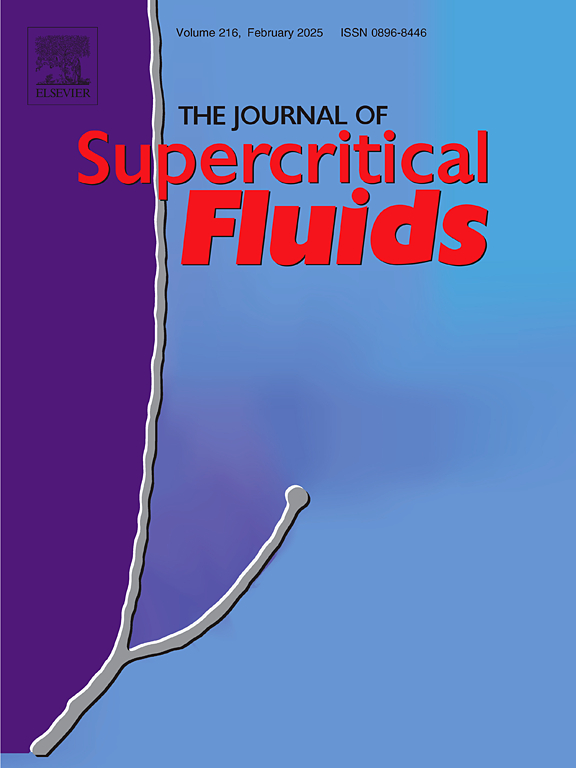含杂质超临界浓相CO2管道输送的热水力特性研究
IF 4.4
3区 工程技术
Q2 CHEMISTRY, PHYSICAL
引用次数: 0
摘要
随着全球气候变化问题的日益严重,实现碳中和和碳峰值已成为各国政府和科学界共同关注的焦点。碳捕集利用与封存(CCUS)技术作为降低大气中二氧化碳浓度的重要手段,对实现这一目标起着至关重要的作用。在CCUS技术的各个方面中,二氧化碳的运输过程尤为关键。然而,超临界和浓相CO2管道输送的统一理论标准尚未完全建立,这在一定程度上限制了CCUS技术的广泛应用和效率的提高。为了填补这一理论空白,本研究采用计算流体力学数值模拟技术,深入研究超临界和浓相CO2在长输管道中的特性。通过模拟实验,考虑了杂质的影响和管道倾角的影响。结果表明,常见杂质如N2、O2和CH4对CO2的相平衡有影响,而H2S对CO2的相平衡没有影响。此外,本研究还深入研究了温度、压力和管径对CO2管道热水力特性的影响,并在此基础上建立了精确的热水力计算模型。进一步分析了4种常见杂质和6种不同管道倾角对管道沿线温度和压力变化的影响。这些发现为二氧化碳长输管道的设计和运行提供了有价值的参考数据,有助于确保运输过程的安全和效率,为未来CCUS项目的实施提供重要的技术支持,有助于推动全球向低碳经济转型,为实现科学上的双碳目标做出贡献。本文章由计算机程序翻译,如有差异,请以英文原文为准。
Thermohydraulic characterization of supercritical and dense-phase CO2 pipeline transportation with impurities
With the increasingly serious problem of global climate change, achieving carbon neutrality and peaking has become a common focus of attention for governments and the scientific community. Carbon Capture, Utilization and Storage (CCUS) technology, as an important means to reduce the concentration of carbon dioxide in the atmosphere, plays a crucial role in achieving this goal. Among the various aspects of CCUS technology, the CO2 transportation process is particularly critical. However, a unified theoretical standard for pipeline transportation of supercritical- and dense-phase CO2 has not yet been fully established, which limits the wide application and efficiency improvement of CCUS technology to some extent. To fill this theoretical gap, this study adopted computational fluid dynamics numerical simulation techniques to thoroughly investigate the characteristics of supercritical- and dense-phase CO2 in long-distance pipeline transportation. Through simulation experiments, this study considered the effects of impurities as well as the inclination of the pipeline. The results show that common impurities such as N2, O2, and CH4 affect the phase equilibrium of CO2, whereas H2S does not. In addition, the effects of temperature, pressure, and pipe diameter on the thermohydraulic characteristics of CO2 pipelines were thoroughly investigated in this study, and an accurate thermohydraulic calculation model was developed on this basis. The effects of four common impurities and six different pipeline inclinations on the temperature and pressure changes along the pipeline were further analyzed. These findings provide valuable reference data for the design and operation of long-distance CO2 pipelines, help ensure the safety and efficiency of the transportation process, provide important technical support for the implementation of future CCUS projects, and help promote the global transition to a low-carbon economy, contributing to the realization of the dual-carbon goal in science.
求助全文
通过发布文献求助,成功后即可免费获取论文全文。
去求助
来源期刊

Journal of Supercritical Fluids
工程技术-工程:化工
CiteScore
7.60
自引率
10.30%
发文量
236
审稿时长
56 days
期刊介绍:
The Journal of Supercritical Fluids is an international journal devoted to the fundamental and applied aspects of supercritical fluids and processes. Its aim is to provide a focused platform for academic and industrial researchers to report their findings and to have ready access to the advances in this rapidly growing field. Its coverage is multidisciplinary and includes both basic and applied topics.
Thermodynamics and phase equilibria, reaction kinetics and rate processes, thermal and transport properties, and all topics related to processing such as separations (extraction, fractionation, purification, chromatography) nucleation and impregnation are within the scope. Accounts of specific engineering applications such as those encountered in food, fuel, natural products, minerals, pharmaceuticals and polymer industries are included. Topics related to high pressure equipment design, analytical techniques, sensors, and process control methodologies are also within the scope of the journal.
 求助内容:
求助内容: 应助结果提醒方式:
应助结果提醒方式:


